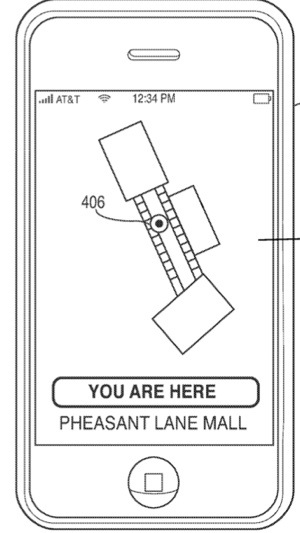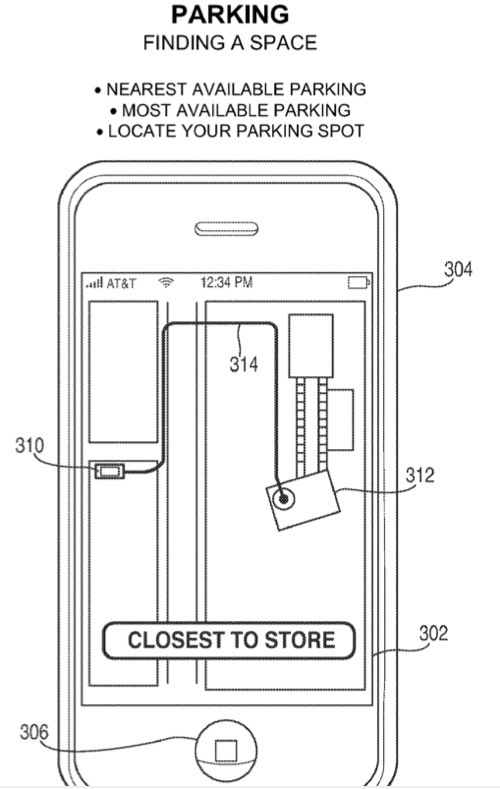An Apple patent (number 20100198626) involving systems and methods for accessing shopping center services using a portable electronic device has appeared at the US Patent & Trademark Office. It's directed to systems and methods for enhancing a user's experience at a shopping center. In particular, it's directed to providing a "heat map" to indicate popular areas of or products in a mall.
In some embodiments, an integrated application available on an electronic device can provide information for promotional and available sales of goods and services, allow a user to browse and search through available content providers of the shopping center, such as parking, restaurants, and clothing stores, to purchase content based on the personal needs of a user. In some embodiments, an application available on an electronic device can check for the availability of particular items and show ratings or reviews for stores carrying the items. In some embodiments, In particular, the integrated application can provide a "heat map" to indicate popular areas of or items in a mall. The inventors are Christine Kim Cho and Stanley Carl Ng.
Here's Apple's summary of the invention: "As shoppers visit shopping malls or various other types of consumer centers, many interactions between the shoppers and the shopping center can take place. For example, a shopper can interact with a parking lot attendant at the shopping center in order to find an available or most convenient parking space, can interact with a shopping mall map or information center to find stores of interest, can interact with a sales clerk to find an item of interest, can interact with magazines and brochures to try and determine what are popular items and stores, and can interact with restaurants and other services at the shopping center to reserve certain services. All of these interactions can require distinct actions from the shopper from different devices or elements. For example, a shopper can talk with a parking attendant, peruse a physical shopping mall directory, and use a phone to make restaurant reservations by calling a restaurant of choice.
"Although this combination of approaches for interacting with a shopping center can be serviceable, it remains cumbersome and requires the shopping center to accommodate all of the possible forms of interaction. From a shopper's perspective, the lack of centralization of interactions with the shopping center provider and with the available shopping-related services can require more effort from the shopper wishing to take advantage of the shopping center, and perhaps even dissuade the shopper from using available services (thus at a cost to the shopping center provider).
"Moreover, this approach may not provide a shopper with the most accurate information regarding what items or stores are popular. For example, a shopper may only have a magazine's or an advertisement's claim that a particular item is currently popular, and may not have any real world data on the popularity of that item (e.g., data such as how often the item is purchased).
"This is directed to systems and methods for providing an integrated application on a portable electronic device for accessing shopping center services. Moreover, this is directed to an integrated application on a portable electronic device for providing a "heat map" to indicate popular areas of or items in a shopping center.
"In some embodiments, the integrated application can interface with one or more service providers (e.g., vendors, shops, restaurants, parking lots, information centers, entertainment venues, or other suitable service providers) in the shopping center to provide access to different services and information made available by a shopping center. As one illustration, the integrated application can receive information from a server of a parking service provider to determine areas of available parking, available parking closest to a desired store, the location of a user's vehicle, or other suitable information related to parking. As another illustration, the integrated application can receive information related to movie times from a server of a movie theater service provider, can receive information related to store hours and available products from a vendor service provider, or receive any other suitable information.
"In some embodiments, the integrated application can receive information from service providers that includes metadata associated with those service providers. The metadata can define, for example, attributes of the goods and services offered by a service provider (e.g., types of clothing, brands of clothing, color, how many of a particular item are currently in stock, types of food, or other suitable attributes), attributes of the service provider (e.g., type of store, hours of operation, location of the store in the shopping center) or any other suitable characteristic of a service provider. Using the metadata, the electronic device can compare goods and services from different stores or providers, and recommend combinations of goods from different stores or providers.
"In some embodiments, the integrated application can provide personalized maps of a shopping center (e.g., maps showing a user's current location in real-time, a map showing preferred service providers, or other personalized map). In some embodiments, special promotions and offers can be received by a user's electronic device through the integrated application. In some embodiments, the integrated application can use the electronic device as a key to access certain goods or services provided by the shopping center service provider (e.g., a key to access to a shopping center's bathrooms, a key to access a specific parking space or elevator, a ticket to purchase a reserved item at a store, or the like).
"The integrated application can interface with servers from several service providers to receive current information as to the availability and price of a particular product. For example, in response to a user selection of a particular item from a catalog displayed by the device, the electronic device can determine, from an appropriate source, the nearest store(s) carrying the item and the prices of the item in each of the stores. In addition to checking availability, the integrated application can provide a user with the ability to search for products, to reserve products (e.g., by pre-paying for an item), to locate stores or other service providers in a shopping center, or any combination of the above.
"In some embodiments, the integrated application can map routes to a desired product. For example, in response to a user indicating they desire "Product A", the integrated application can locate a store currently possessing Product A, and then display a map showing a route from the user's current location to the located store. As another example, in response to a user indicating they desire several products, the integrated application can locate one or more stores currently possessing these products, and then generate a route through the shopping center that can bring the user to each of the stores. The generated route may, for example, be a shortest route that takes the user to the stores, a route the allows the user to end at a desired location (e.g., the user may desire to end their shopping near a Food Court so they can eat, or the user may desire to end their shopping near an exit to a parking lot), or any other suitable route.
"To assist users in purchasing new content at the shopping center, the integrated application can provide product recommendations based on user preferences. For example, the integrated application can compare a database of user preferences to information related to new products to determine whether there are any matches. As another example, the integrated application can include or access a database storing information reflecting the items already owned by the user. The integrated application may then compare new items in the shopping center with the items already owned by the user, and provide recommendations to a user based on these comparisons.
"In some embodiments, a 'heat map' can be provided to indicate the popularity of a service provider, product, or both to a user. For example, the integrated application can receive information related to stores in which a lot of customers are currently purchasing items, or related to the number of a particular product that is being purchased. Based on this information, the integrated application can then determine which service providers, products, or both are currently popular (e.g., where a product or service provider can be considered more popular when more people are buying this product or making purchases at this store, respectively). The integrated application may then generate a heat map to symbolically display the popularity of service providers, products, or both to a user."














